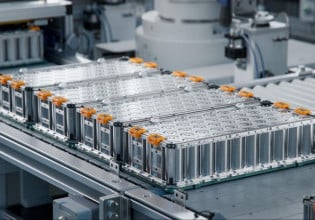DENSO Targets Automotive Stop/Start Systems with Li Battery Pack
DENSO Corporation has developed a lithium-ion battery pack that further increases the fuel efficiency of vehicles with stop/start systems. DENSO's new battery pack allows the stop/start system to use more regenerative power than current systems that use a single lead-acid battery. DENSO's battery pack consists of a battery management unit and power supply control switch, as well as battery cells that are provided by a third-party source.
DENSO's new lithium-ion battery pack stores regenerated power and then supplies the stored regenerated power to the electrical and electronic components, such as the car navigation and audio systems. This reduces the power generation required by the alternator, which results in an overall load reduction on the engine and improves the vehicle's fuel economy.
The new battery pack is naturally air-cooled and therefore does not require a dedicated cooling system. Because there is no need for auxiliary cooling components, this allows the battery to be lighter and more compact. This enables automakers more packaging design flexibility, which is important for vehicles with limited space.
DENSO has developed different types of starters to meet the specific needs of its customers for their stop/start systems, including the Advanced Engagement (AE) Starter, Permanently Engaged (PE) Starter, and Tandem Solenoid (TS) Starter. Also, DENSO developed a Cold Storage (CS) Evaporator which increases the effectiveness of idle-stop, particularly at high temperatures. DENSO supplies the lithium ion battery pack, the TS starter and Cold Storage Evaporator on the Suzuki Wagon R, which Suzuki Motor Corporation launched to market earlier this month. DENSO will continue its efforts to expand these technologies to other automakers and other regions in the world.
About the Battery Pack Components
1. DENSO Battery management unit
DENSO Battery Management Unit monitors and controls the voltage of the lithium-ion battery cells to maintain the proper charge level to protect them from overcharge and over-discharge.
2. Power supply control switch
Depending on the operational status of the vehicle, this device controls the charging of the battery cells by the energy captured during deceleration and braking. It also controls the amount of power supplied to the car navigation, audio, and other systems during driving.
3. Battery cells
High-power rechargeable lithium-ion battery cells, which have a higher energy density and charge more quickly than lead-acid batteries, can efficiently store more regenerated power quickly to vehicle's electronic and electrical components.






